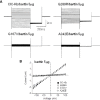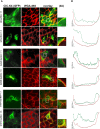Functional Study of Novel Bartter's Syndrome Mutations in ClC-Kb and Rescue by the Accessory Subunit Barttin Toward Personalized Medicine
- PMID: 32256370
- PMCID: PMC7092721
- DOI: 10.3389/fphar.2020.00327
Functional Study of Novel Bartter's Syndrome Mutations in ClC-Kb and Rescue by the Accessory Subunit Barttin Toward Personalized Medicine
Abstract
Type III and IV Bartter syndromes (BS) are rare kidney tubulopathies caused by loss-of-function mutations in the CLCNKB and BSND genes coding respectively for the ClC-Kb chloride channels and accessory subunit barttin. ClC-K channels are expressed in the Henle's loop, distal convoluted tubule, and cortical collecting ducts of the kidney and contribute to chloride absorption and urine concentration. In our Italian cohort, we identified two new mutations in CLCNKB, G167V and G289R, in children affected by BS and previously reported genetic variants, A242E, a chimeric gene and the deletion of the whole CLCNKB. All the patients had hypokalemia and metabolic alkalosis, increased serum renin and aldosterone levels and were treated with a symptomatic therapy. In order to define the molecular mechanisms responsible for BS, we co-expressed ClC-Kb wild type and channels with point mutations with barttin in HEK 293 cells and characterized chloride currents through the patch-clamp technique. In addition, we attempted to revert the functional defect caused by BS mutations through barttin overexpression. G167V and A242E channels showed a drastic current reduction compared to wild type, likely suggesting compromised expression of mutant channels at the plasma membrane. Conversely, G289R channel was similar to wild type raising the doubt that an additional mutation in another gene or other mechanisms could account for the clinical phenotype. Interestingly, increasing ClC-K/barttin ratio augmented G167V and A242E mutants' chloride current amplitudes towards wild type levels. These results confirm a genotype-phenotype correlation in BS and represent a preliminary proof of concept that molecules functioning as molecular chaperones can restore channel function in expression-defective ClC-Kb mutants.
Keywords: Bartter’s syndrome; barttin; kidney chloride channels; patch clamp; pharmacology.
Copyright © 2020 Sahbani, Strumbo, Tedeschi, Conte, Camerino, Benetti, Montini, Aceto, Procino, Imbrici and Liantonio.
Figures





Similar articles
-
Functional severity of CLCNKB mutations correlates with phenotypes in patients with classic Bartter's syndrome.J Physiol. 2017 Aug 15;595(16):5573-5586. doi: 10.1113/JP274344. Epub 2017 Jun 27. J Physiol. 2017. PMID: 28555925 Free PMC article.
-
Regulation of ClC-K/barttin by endocytosis influences distal convoluted tubule hyperplasia.J Physiol. 2024 Sep;602(17):4291-4307. doi: 10.1113/JP286729. Epub 2024 Aug 6. J Physiol. 2024. PMID: 39106251
-
Role of zebrafish ClC-K/barttin channels in apical kidney chloride reabsorption.J Physiol. 2019 Aug;597(15):3969-3983. doi: 10.1113/JP278069. Epub 2019 Jul 3. J Physiol. 2019. PMID: 31177533
-
Bartter's syndrome: clinical findings, genetic causes and therapeutic approach.World J Pediatr. 2021 Feb;17(1):31-39. doi: 10.1007/s12519-020-00370-4. Epub 2020 Jun 1. World J Pediatr. 2021. PMID: 32488762 Review.
-
ClC-K chloride channels: emerging pathophysiology of Bartter syndrome type 3.Am J Physiol Renal Physiol. 2015 Jun 15;308(12):F1324-34. doi: 10.1152/ajprenal.00004.2015. Epub 2015 Mar 25. Am J Physiol Renal Physiol. 2015. PMID: 25810436 Review.
Cited by
-
Chloride channels and mast cell function: pioneering new frontiers in IBD therapy.Mol Cell Biochem. 2025 Jul;480(7):3951-3969. doi: 10.1007/s11010-025-05243-w. Epub 2025 Mar 4. Mol Cell Biochem. 2025. PMID: 40038149 Review.
-
ClC-K Kidney Chloride Channels: From Structure to Pathology.Handb Exp Pharmacol. 2024;283:35-58. doi: 10.1007/164_2023_635. Handb Exp Pharmacol. 2024. PMID: 36811727
-
Long-read sequencing identifies a common transposition haplotype predisposing for CLCNKB deletions.Genome Med. 2023 Aug 23;15(1):62. doi: 10.1186/s13073-023-01215-1. Genome Med. 2023. PMID: 37612755 Free PMC article.
-
Kidney ion handling genes and their interaction in blood pressure control.Biosci Rep. 2022 Nov 30;42(11):BSR20220977. doi: 10.1042/BSR20220977. Biosci Rep. 2022. PMID: 36305246 Free PMC article. Review.
References
LinkOut - more resources
Full Text Sources
Miscellaneous

